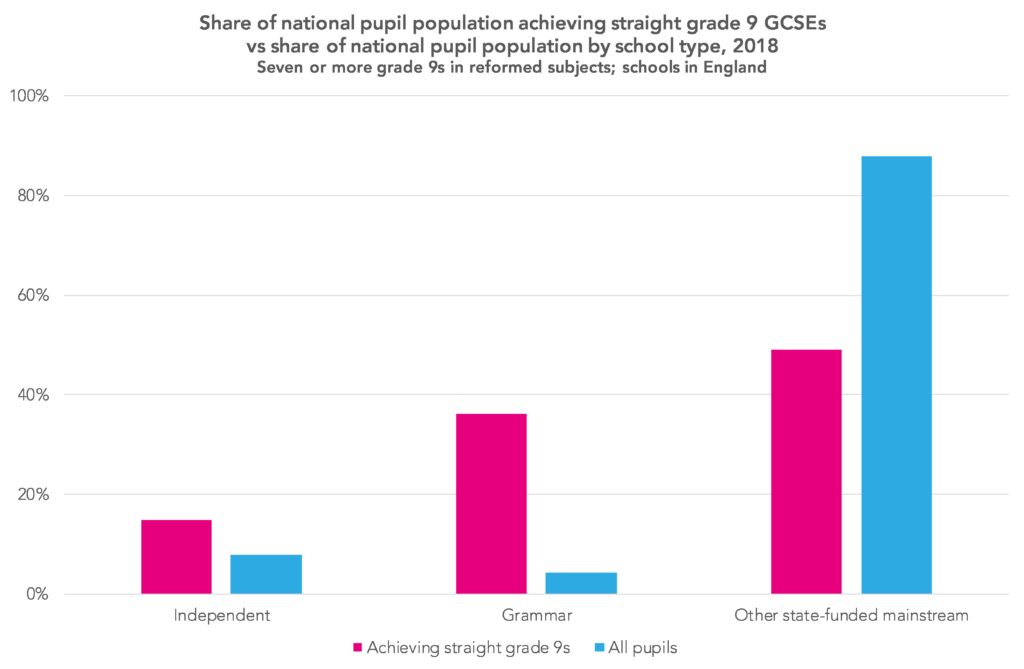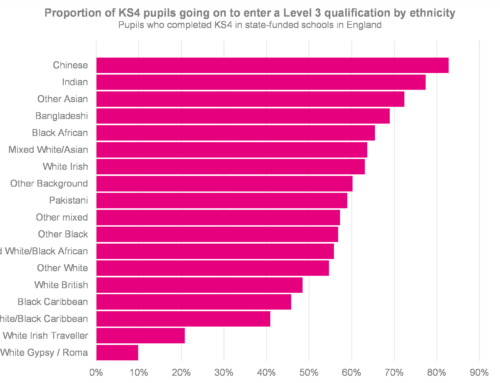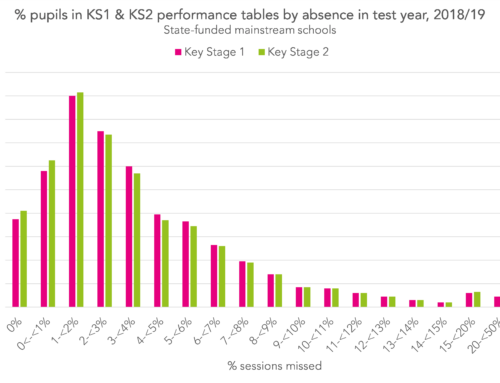One question we’ve been asked repeatedly over the last year is how many pupils achieved seven/eight/nine/more straight grade 9 GCSEs in 2018.
So what’s the answer?
The what
Last year Ofqual reported that 732 pupils in England entered at least seven reformed GCSEs and achieved a grade 9 in each and every one of them.
After revisions and amendments to results are taken into account we put the figure at 818 pupils. (We’re counting double science as two entries here.)
And some pupils didn’t stop at seven.
In total, we think:
- 78 pupils achieved seven grade 9s;
- 114 pupils achieved eight;
- 290 pupils achieved nine;
- 250 pupils achieved 10;
- 81 pupils achieved 11;
- five pupils achieved 12.

The who
Who were the pupils who achieved such remarkable results?
A note on coverage
All figures in this post relate to England only – though results for Wales and Northern Ireland will also be published on Thursday.
Looking at gender first, more girls than boys were among the 818 pupils achieving seven grade 9s or more: 496 compared to 322. Only 22 of the pupils were disadvantaged, however. (Information on disadvantage is only available for those pupils in the state sector – but most of these 818 pupils were.)
And although white British pupils make up 70% of the state-funded pupil population they only accounted for 57% of pupils in state schools achieving at least seven straight grade 9s. Chinese and Indian pupils were the most overrepresented among this group of very high achievers – in line with the general high attainment of Chinese and Indian pupils.
The where
We might wonder whether those achieving the very largest stacks of grade 9s were in the independent or the state sector.
Of the 336 pupils who achieved 10 or more straight grade 9s, just 16 were in the independent sector. And looking at the very top of the grade 9s pile, all five pupils achieving 12 or more were in the state-funded sector.
This perhaps says as much about entry patterns in the two sectors as it does about attainment, however. Pupils in independent schools might also have taken international GCSEs (not counted in these figures) and in some cases state schools place more emphasis on helping pupils rack up large numbers of GCSEs than do independent schools.
Pupils in the independent sector were overrepresented among the 818 pupils achieving at least seven straight grade 9s – but not by as much as pupils at grammar schools.
The chart below compares the share of pupils who achieved seven or more straight grade 9s to the share of the pupil population in each type of school. Only around 4% of the age 16 population are in grammar schools, but fully 36% of the pupils who achieved seven or more straight grade 9s were in grammar schools.

Similarly, pupils in London, and to a lesser extent the south east, were overrepresented among the straight grade 9 group, as the chart below shows. Again, this fits with what we know about these regions performing well in general at GCSE and other levels.

The how
We looked last year at the subjects in which pupils were achieving more grade 9s, identifying classical subjects and the single sciences among those with the greatest share of grade 9s.
But this tells us more about the typical attainment of the pupils entering each subject than it does about the ‘easiness’ of any given subject.
Celebrating achievement
Each pupil has a different starting point and many factors that influence their attainment, and there should be a celebration of pupils’ achievements at all levels of attainment.
For those achieving a grade 9, this shows real mastery of the subject matter. And we wanted to write this post so that those gaining multiple grade 9s could realise quite what an achievement that is.
We’ll be publishing live analysis of this year’s GCSE results from 9.30am on Thursday. Sign up to our mailing list to be notified about these blogposts, or check back here on the day.
In the meantime, take a look at our microsite, which allows you to explore trends in GCSE entries and attainment yourself. We’ll be adding 2019 data at 9.30am on Thursday.







Stupid stats. Why consider only straight 9s? Why not consider all 9s? Many be 1500 achieved 8 level 9s and 2 level 8s. This is not included on stats as they are not straight 9s.